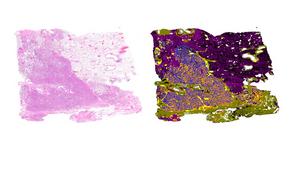
image:
The image shows how the algorithm processes the typically coloured tissue section (left) and creates a map in which different types of tissue can be seen in different colours (the algorithm identifies all tissue types that can be found in tissue sections). Blue is the tumour, in this case an adenocarcinoma of the lung. Orange in the vicinity of the tumour is the peritumoural tissue = microenvironment of the tumour with immune cells.
Credit: Dr Yuri Tolkach
A team of researchers from the University of Cologne’s Faculty of Medicine and University Hospital Cologne, led by Dr Yuri Tolkach and Professor Dr Reinhard Büttner, has created a digital pathology platform based on artificial intelligence. The platform uses new algorithms developed by the team and enables fully automated analysis of tissue sections from lung cancer patients. The platform makes it possible to analyse digitized tissue samples on the computer for lung tumours more quickly and accurately than before. The study ‘Next generation lung cancer pathology: development and validation of diagnostic and prognostic algorithms’ has been published in the journal Cell Reports Medicine.
Lung cancer is one of the most common tumours/cancers in humans and has a very high mortality rate. Today, the choice of treatment for patients with lung cancer is determined by pathological examination. Pathologists can also identify molecularly specific genetic changes that allow for personalized therapy. Over the past few years, pathology has undergone a digital transformation. As a result, microscopes are no longer needed. Typical tissue sections are digitized and then analysed on a computer screen. Digitalization is crucial for the application of advanced analytical methods based on artificial intelligence. By using artificial intelligence, additional information about the cancer can be extracted from pathological tissue sections – something that would not be possible without AI technology.
“We also show how the platform could be used to develop new clinical tools. The new tools can not only improve the quality of diagnosis, but also provide new types of information about the patient’s disease, such as how the patient is responding to treatment,” explained physician Dr Yuri Tolkach from the Institute of General Pathology and Pathological Anatomy at University Hospital Cologne, who led the study.
In order to prove the broad applicability of the platform, the research team will conduct a validation study together with five pathological institutes in Germany, Austria and Japan.
Media Contact:
Dr Yuri Tolkach
Institute of General Pathology and Pathological Anatomy, University Hospital Cologne
+49 221 478 87023
iurii.tolkach@uk-koeln.de
Press and Communications Team:
Mathias Martin
+49 221 470 1705
m.martin@verw.uni-koeln.de
Publication:
DOI: 10.1016/j.xcrm.2024.101697
Press Spokesperson: Dr Elisabeth Hoffmann – e.hoffmann@verw.uni-koeln.de
Journal
Cell Reports Medicine
Method of Research
Imaging analysis
Subject of Research
Cells
Article Title
Artificial intelligence improves lung cancer diagnosis
Article Publication Date
22-Aug-2024
Disclaimer: AAAS and EurekAlert! are not responsible for the accuracy of news releases posted to EurekAlert! by contributing institutions or for the use of any information through the EurekAlert system.



